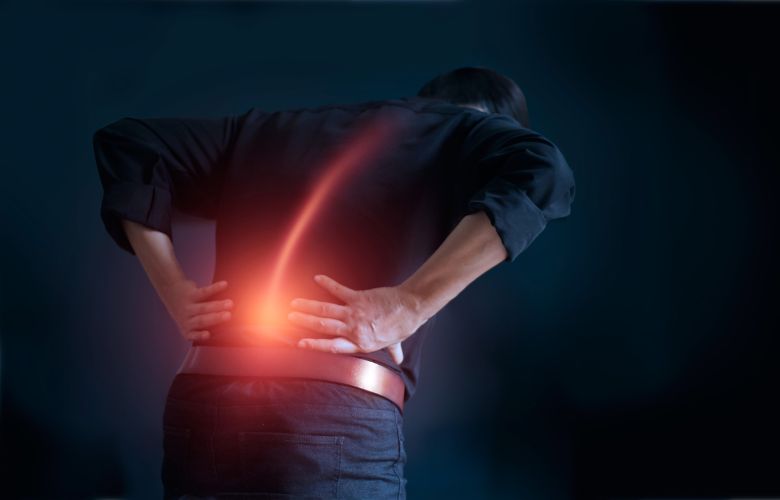Are you suffering from chronic low back pain as a result of bad posture, extended periods of sitting, a passive lifestyle, or previous injuries? Managing this discomfort can be both physically and mentally exhausting. If you’re seeking a comprehensive solution to not only achieve your fitness goals but also gain significant relief from lower back pain, consider the life-changing benefits of EMS training. This method stands out for its ability to target specific muscle groups without imposing unnecessary stress on the spine, making it different from conventional exercises.
In this blog post, we will look at some selected ways in which EMS training can effectively reduce lower back pain. By identifying the root cause of your discomfort, EMS training offers a tailored approach to not only reduce pain but also restore your freedom of movement without constraints.
Knowing about EMS

Before we explore the ways and benefits of EMS training for lower back pain, let’s break down the basics of Electrical Muscle Stimulation (EMS). EMS is an effective pain management and rehabilitation therapy that uses regulated electrical impulses to stimulate and contract muscles. EMS training provides a focused and non-invasive approach. Understanding how EMS directly employs muscle fibres via electrical stimulation allows us to learn about its application in strengthening specific muscle groups that are important for lower back support. This targeted muscle stimulation is especially effective for those who have busy lifestyles, poor posture, long sitting, or previous injuries, all of which contribute to lower back stiffness. Unlike traditional exercises, which can strain the lower back, EMS allows for specific muscle targeting while minimising spinal stress.
Ways To Reduce Lower Back Pain Using EMS

Here in this section, we will examine how to strategically use EMS training to help you achieve lower back pain relief and an improved sense of general well-being. Let us examine the potential uses of EMS in the treatment and prevention of lower back pain.
Alleviate Pain By Enhancing Blood Flow
Using Electrical Muscle Stimulation (EMS) on the lower back is essential for promoting ideal blood flow, which is important for improving general health. EMS produces a dynamic response that stimulates blood vessels by creating rhythmic muscle contractions through regulated electrical impulses. Several advantages result from this increased circulation, such as better nutrition delivery, more effective waste removal, and increased oxygen supply. All of these elements work together to support the strength, healing, and hydration of the lower back muscles, making EMS an effective preventative measure for developing a stronger and healthier lower back.
The targeted application of EMS allows it to be used selectively to address both the real causes and symptoms of lower back pain. EMS plays an important role in the overall process of achieving pain relief and maximum function in the lower back by stimulating enhanced circulation, which aids in the reduction of stiffness, increased flexibility, and a generally improved condition of your lower back.
Building Up Your Core Muscles
An effective method for enhancing lower back stability and functionality is the controlled stimulation of core muscles through EMS training. EMS uses regulated contractions to target core muscular groups such as the lower back and abdominals, imitating the organic movements of traditional exercises. This method prioritises functional characteristics that have a direct impact on lower back well-being. Strengthening the core muscles is essential for reducing lower back pain, and EMS can help with that.
EMS technology serves two main purposes concerning lower back pain. Firstly, it acts as a stabilising force, providing support to the lower back and relieving pressure on the lumbar spine. Secondly, it helps prevent lower back pain caused by poor posture by strengthening the core muscles, which maintain balance and alignment in the skeletal system. As more research is done on EMS, it is becoming increasingly evident that this technology offers a complete solution by addressing the main factors that contribute to lower back discomfort and developing functional strength while maintaining good spinal health.
Reduces Pain By Enhancing Flexibility
Electrical Muscle Stimulation (EMS) is a precise and customised method for improving lower back flexibility. With the use of regulated electrical impulses, EMS targets particular muscle groups to trigger movements that enhance the range of motion and decrease stiffness. The most important aspect of maintaining good lower back health is flexibility, which is accomplished by EMS through the imitation of natural stretching motions.
EMS increases lower back flexibility through focused muscle engagement, allowing the spine to move freely during a variety of activities. This benefit actively helps to minimise pain and strain, in addition to lessening the risk of discomfort. EMS actively fights stiffness, which is particularly beneficial for individuals who experience challenges associated with long periods of inactivity. The regulated contractions induced by EMS help muscles stretch and relax, reducing stiffness and promoting a more flexible and adaptive lower back. So, if you’re dealing with lower back pain caused by sitting for long periods of inactivity, EMS can be a considerable option to help you reduce that pain and discomfort.
Helps In Relieving Inflammation
Electrical Muscle Stimulation (EMS) is a smart choice for relieving lower back pain, especially when it comes to tackling inflammation. By sending controlled electrical impulses, EMS can be a considerable and reliable option for those seeking relief from pain. Muscle cramps produced by EMS therapy affect the body’s inflammatory response and improve blood flow. This in turn promotes the efficient removal of inflammatory contaminants, which speeds up the lower back’s healing process.
Electrical Muscle Stimulation (EMS) is important for reducing inflammation and improving lower back health. EMS training can directly decrease the pain and discomfort associated with inflammation, improving the overall quality of life for those affected. The inherent anti-inflammatory effects of EMS considerably contribute to the improvement of lower back mobility. As the inflammation reduces, it automatically reduces the problems associated with stiffness and restricted movement, resulting in a greater range of motion and increased flexibility. Recommending EMS for inflammation treatment is a wise decision for anyone looking to improve their lower back health.
Encourage Immediate Pain Relief
Electrical Muscle Stimulation (EMS) training is a specific way to help with lower back pain. Instead of just treating the pain’s signs, EMS alleviates pain directly rather than just treating the symptoms. It does this by using carefully adjusted electrical signals that target the exact muscles causing the pain in your lower back. This specific approach ensures that relief goes straight to where it’s needed, giving you immediate comfort.
EMS offers targeted stimulation to the muscles causing lower back pain, ensuring a precise response to discomfort. It actively engages with the muscles, promoting controlled contractions that work to correct imbalances and enhance overall muscle health. This comprehensive approach presents EMS training as an ideal means of providing immediate assistance as well as an effective method of promoting the long-term health of the lower back.
Muscle Hypertrophy And Activity
The effect of Electrical Muscle Stimulation (EMS) on stimulating muscle growth and activity shows an extensive list of effects on lower back health. Aside from its acute pain relief benefits, EMS has a significant impact on the general health and resilience of the lower back muscles. By coordinating regulated contractions, EMS initiates the process of muscular hypertrophy, allowing muscle fibres to expand. This growth is crucial for strengthening the lower back muscle’s strength and endurance, creating the basis for long-term support.
EMS technology has a significant impact on enhancing muscular activity beyond just providing symptomatic relief. The controlled electrical impulses produced by EMS mimic the natural patterns of muscle engagement, leading to sustained muscle activity. Regular use of EMS not only helps to relieve pain but also supports the maintenance of optimal muscle tone and function. EMS is a proactive approach to actively strengthening the lower back muscles and preparing them to resist the daily pressures of ordinary activities because of its dual action. In short, EMS becomes an important tool for developing strong and resilient lower back muscles for long-term well-being in addition to treating pain symptoms.
Stress Reduction
The study of the relationship between EMS training and stress reduction suggests an integrated approach to managing lower back pain. While EMS is well-known for its physical effects in treating lower back pain, it also actively contributes to nervous system relaxation. EMS not only relieves physical strain but also encourages a therapeutic response in the neural system, promoting relaxation and lowering overall stress levels by regulating electrical impulses that cause rhythmic muscle contractions.
Lower back discomfort is frequently influenced by both physical and psychological causes, such as strain and stress. Because of the dual effect of EMS on the neurological system, an integrated approach to pain management is formed, addressing not only the physical symptoms of pain but also the emotional and mental components of pain. EMS training turns into a versatile and comprehensive tool by actively engaging both components, giving individuals a way to not only treat lower back pain but also build a balanced and complete sense of health.
Maintain Flexibility With These Exercises For Lower Back Pain

Dynamic Planking With EMS
Plank exercise is good for strengthening your core muscles, which include the muscles of your lower back. By adding EMS to your plank exercise, you can actively engage your lower back and core muscles. The intensity of the plank is increased by the controlled electrical impulses, which makes it possible for muscles that are crucial for lower back support to contract more forcefully. This method of enhancing flexibility and core strength effectively combines traditional planking with EMS technology.
EMS-Powered Russian Twists
Russian twists can be made into a dynamic exercise that targets the abdominal and lower back muscles while also utilising EMS. EMS increases the difficulty by introducing regulated contractions via electrical impulses. This intensifies muscular activation. The increased intensity of your workout not only benefits waistline contouring but also improves lower back flexibility.
Elevate Your Bridges With EMS
Bridges work on your lower back, glutes, and hamstrings. Adding Electrical Muscle Stimulation (EMS) maximises muscle activation, speeding up your progress. EMS brings extra resistance, boosting flexibility and strength in the key muscles supporting your lower back. This dynamic combo of traditional exercise and EMS technology not only enhances effectiveness but also moves you toward a stronger and more flexible lower back.
Superman Integrated With EMS
The Superman exercise strengthens the lower back muscles and improves posture. Integrate EMS technology into this traditional workout to target the entire back, especially the lower back, to promote spinal extension and flexibility. EMS-controlled muscle contractions enhance the Superman exercise, making it an effective tool for strengthening the lower back and increasing flexibility.
Optimise Your Deadlifts With EMS Integration
Modify your deadlift regimen by adding EMS to get a more intense and efficient lower back workout. You can increase your strength gains and the intensity of your muscle activation by adding EMS to this exercise. This fusion strengthens the muscles that are essential for preserving a healthy lower back, in addition to improving flexibility.
Conclusion
EMS’s effectiveness in treating back pain is rooted in its unique ability to activate deep muscle fibres, which are frequently hard to reach with traditional exercise alone. EMS training is a useful addition to any exercise routine for reducing lower back pain. The blog highlights seven practical ways EMS training can effectively reduce lower back pain. From dynamic planking to enhanced deadlifts, these strategies showcase how versatile the EMS technology is in targeting specific muscles, reducing stress, and promoting flexibility. By using these exercises, you could promote the base of long-term lower back health along with treating any present pain and discomfort.



